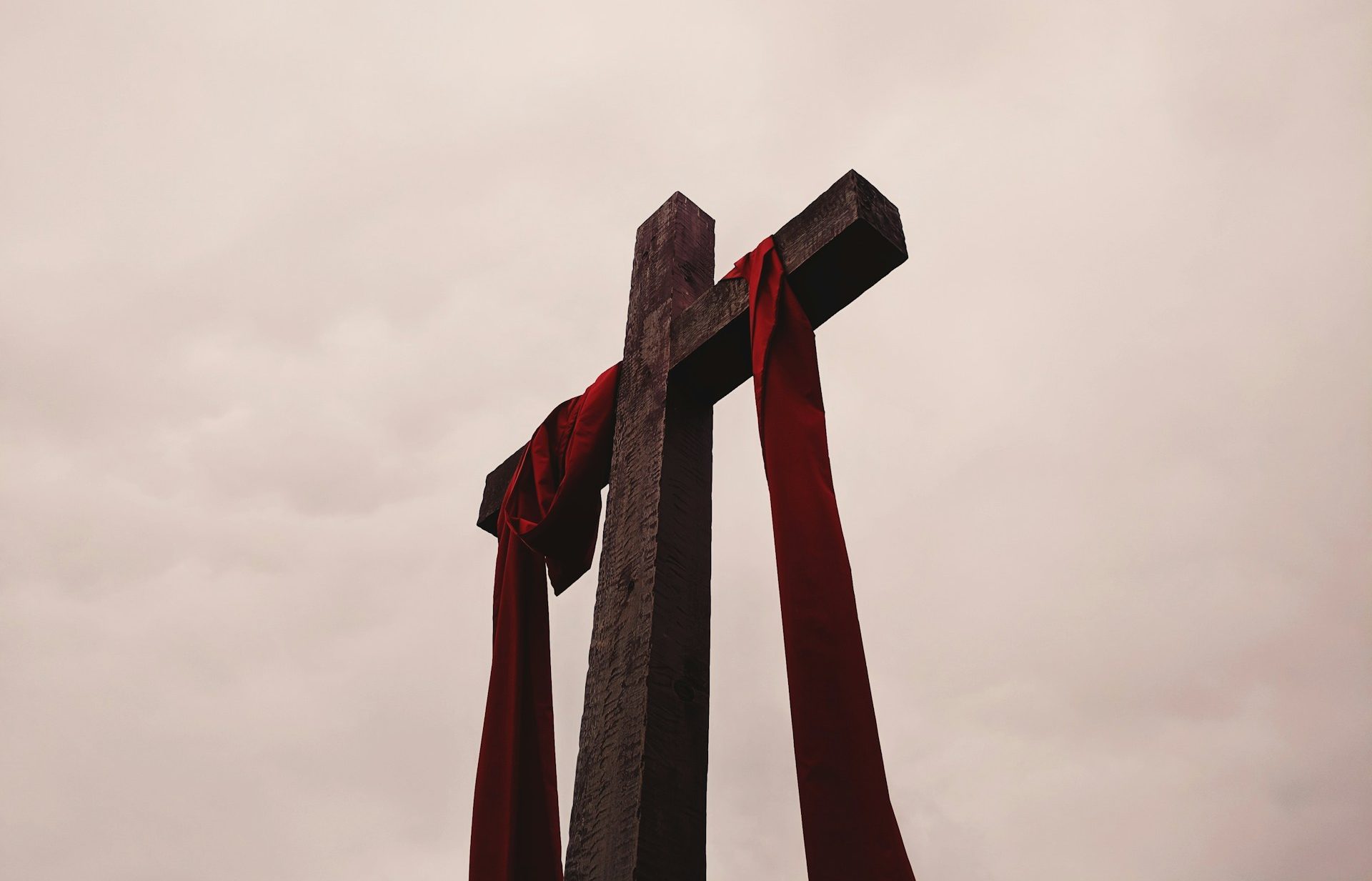In my early years as a church planter, I once participated in a Q&A panel at a local university to interact with students’ questions about faith and spirituality. One student, sitting attentively in the back of the auditorium, wiping his tangle of curly hair away from his eyes every so often to scribble some notes into a notebook. Near the end of the event, his hand shot up.
“What is the whole deal,” he asked, “with the cross?”
You see lots of crosses in churches and on Christian buildings and stuff. And Jesus is always on the cross in Christian artwork. Why is he always pictured on a cross? Why is that so important?” I told him that he, knowingly or not, was asking one of the most central questions of the Christian faith.
What is God doing for us through the death of Jesus? Christians have reached to find language adequate to describe this bottomless mystery for millennia now. The explanations that the church has developed for what transpired in the cosmos as Jesus endured the Cross are sometimes called atonement theories, and Christian thinkers have developed a variety of them—all of them admittedly only partially adequate to give human expression to a measureless wonder. With the help of Fleming Rutledge’s book, The Crucifixion, (a most helpful contemporary book on the Atonement, in my opinion) I’ve compiled four of the main reasons why Jesus had to die for us.
#1 Rescue
The dramatic story of the Exodus is one of the most well known in the world. The living God hears the pained cries of the Hebrew people, who are, at the time, a tribe of nobodies, languishing in slavery under the thumb of the Egyptian pharaoh. God rolls up his divine sleeves and emancipates them in breathtaking fashion. He parts the Red Sea, bringing them through certain death to the other side and into a new life as his own family.
It’s no accident that Jesus was crucified at the Passover Festival—the annual festival in which the Jewish people would rehearse the Exodus story and remember their freedom and identity. By the first century, the Israelites were looking for God to do an Exodus again—to free them from Rome’s tyrannical clutches.
At the Cross, God is accomplishing an exodus—not just to free one group of people from sociopolitical oppression at the hands of the empire du jour but to liberate the whole world from our older, darker foes: sin and death. Jesus’ death rescues us from death and looses us into new life.
#2 Victory
It’s through a cross—that ultimate symbol of defeat and shame—that God, through Christ, parades in cosmic triumph. God wins the ultimate victory over the evil oppressing us and the universe by absorbing the worst of it. God defeats our violence and injustice by suffering our violence and injustice. At the death of Jesus, God once and for all puts the power of death to death.
This ironic inversion turns up everywhere in the Christian Scriptures. The Gospel of Matthew, for example, narrates Jesus’ trial, suffering, and death like an enthronement ceremony, with Jesus repeatedly being called “King of the Jews” (See Matthew 27:11, 29, 37)—but not at the head of an army or in the throne room of a palace. Jesus is lauded as King as he’s mocked, tortured, and executed. This, Matthew announces, is what the world’s true King is like: He loves us enough to be nailed to his throne.
The final word in the Bible, the Revelation to John, repeats this refrain too. John’s wild, apocalyptic visions of heaven (God’s dimension of reality) picture all the cosmos celebrating the victorious God; but God is identified together with a Lamb, sacrificially slain, and it’s through the Lamb’s sacrifice that God wins the ultimate cosmic victory over evil and death. (For example, Revelation 5:1-14)
#3 Sacrifice
As you read your way through the Bible, you’ll discover quite a lot of material related to sacrifices. In Jewish practice, you’d offer a sacrifice to redeem, or buy back, your firstborn son as a way to remember that all life is a gift from God. You’d offer sacrifices in thanks to God for the year’s harvest. You’d sacrifice to demonstrate God’s forgiveness, which does away with guilt and reunites humanity and God in peace. It’s no surprise, then, that this is one main way the early Christians talked about the death of Jesus: The shedding of his blood was the sacrifice to end all sacrifices, the once-for-all act to make atonement for—that is, to pay for—the sin of the world and open a “new and living way” (See Hebrews 10:20) for us to be reconciled with the God we’re made for. Think of the origin of the word atonement: It’s literally “at-one-ment”; through Jesus’ sacrifice, we’re reunited with our Creator.
When talking about the story of the Cross, I’ve often listened to people wonder, “Why does Jesus have to die for God to forgive people? Can’t God just choose to forgive?” But anyone who’s ever attempted to forgive an unfaithful spouse or the betrayal of a trusted coworker or the failures of a parent implicitly understands the answer to this question—forgiveness is costly.
#4 Revelation
One of the most magnificent poems in the Bible is the soaring first section of the Gospel of John. I was inspired by the insights on the gospel of John and the literary rhythm of “and the Word became flesh . . . and we have seen his glory” drawn from N. T. Wright’s Following Jesus. Wright points out that the first eighteen verses are multilayered, symphonic: In introducing us to Jesus, John draws together light and darkness, Hebrew Scripture and Greek philosophy, the Creation story and the Exodus events. At the climax of this passage, John trumpets that “the Word became flesh and lived among us, and we have seen his glory, the glory as of a father’s only son, full of grace and truth.” (See John 1:14) John wants us to watch the story of Jesus unfold and experience the staggering realization This is what the invisible God is really like!
John organizes his Gospel around signs that Jesus performs, which unveil, one after another, just who this mysterious Teacher from Galilee truly is. And just as the Creation poetry of Genesis 1 is organized around seven days of Creation, the Gospel of John is shaped by seven of Jesus’ signs. So, for example, in John 2, Jesus creates 180 gallons or so of the very best wine for the wedding of someone who may have been a family friend. And after telling us the story, John adds: “Jesus did this, the first of his signs, in Cana of Galilee, and revealed his glory.” (See John 2:11) He wants us to watch Jesus and realize for ourselves: The Word became flesh and celebrated a wedding, and we have seen his glory—glory as of the One who lavishes on us the wine of God’s joy.
Two chapters later, Jesus heals a royal official’s son . . . and the Word became flesh and healed a sick boy, and we have seen his glory, the glory as of the One who heals our diseases.
In John 6, Jesus feeds hungry masses on a desolate Galilean hillside . . . and the Word became flesh and fed thousands, and we have seen his glory, the glory as of the One who gives food to the hungry.
All in all, there are six miraculous signs in John 1–11, culminating in Jesus’ raising of his friend Lazarus from death. And then, beginning in John 12, we follow Jesus to Jerusalem and ultimately to his death. So what’s the final, seventh sign in John’s narrative architecture? The Cross.
And the Word became flesh and died among us. And we have seen his glory, the glory as of the One who laid down his life on our behalf.
Ultimately, it’s when we look at the bent figure of Jesus of Nazareth, nailed to the rough wood of a Roman execution instrument, mocked by the religious establishment, sneered at by passersby, bleeding and expiring, “for us and for our salvation,” that we truly discover, this is what the God of the universe is really like.

Jared Ayers
is a pastor, speaker, professor, and writer. He is a graduate of Western Theological Seminary and the Eugene Peterson Center for Christian Imagination. A pastor for more than two decades, he currently serves as Senior Minister at First Presbyterian Church in North Palm Beach, FL., and as adjunct faculty at Palm Beach Atlantic University. Jared is married to his wife Monica, and they’ve been graced with two sons and a daughter.


